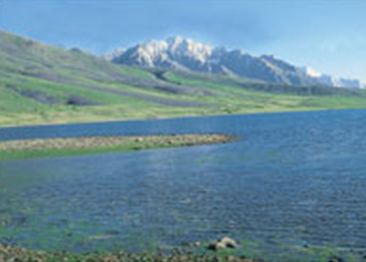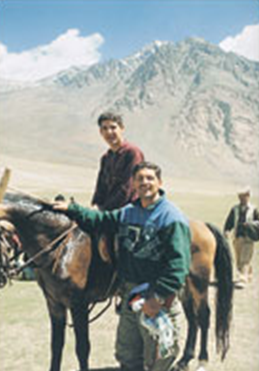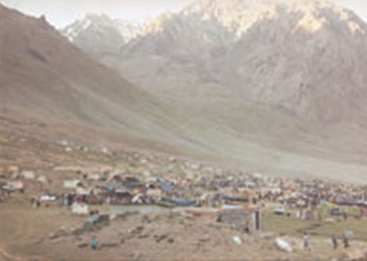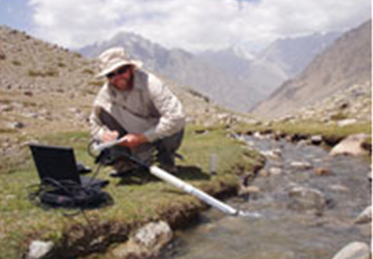Shandur/ Shindhur
This is a collection of articles archived for the excellence of their content. Readers will be able to edit existing articles and post new articles directly |
Shandur/ Shindhur
Pollution at the top of the world
By Rina Saeed Khan
Before the tournament became a regular event in the mid-1980s, Shandur Lake, which lies in a depression not more than 15 feet deep, was an important refuge for migratory birds since it lies along an international migratory bird route. With the establishment of a regular polo tournament and a permanent rest house on the pass, Shandur Lake could no longer offer a pristine haven for the ducks, and eventually the birds stopped nesting there, reports Rina Saeed Khan
For most of the year the Shandur Pass, perhaps the most famous of the high mountain passes of the Hindu Kush mountain range, remains desolate. Then in the month of July, when the celebrated Shandur Polo Festival takes place between teams from Chitral and Gilgit, this isolated wilderness undergoes a dramatic change. Although it has been declared a protected area and is considered a national park, over the years the impact of this annual tournament on Shandur’s fragile natural environment has extracted a heavy price.
Nowadays, Shandur is known throughout the globe as the ‘world’s highest polo ground’ and the government is keen to promote the site as an international tourist destination. But by ignoring the environmental impacts of the tournament, officials are neglecting to safeguard the pass from human pollution. This is a continual pattern –– the government is keen to promote tourist sites all over Pakistan, however, it is not interested in protecting these sites from environmental degradation.
Located at 12,205 feet above sea level, the Shandur Pass is a picturesque plateau with three small lakes, encircled by snowcapped peaks. There is no surface drainage from the lakes and they are fed by melted snow from the peaks that rise to a height of 2,000 feet above the pass. The Chitral Scouts have constructed a small rest house and permanent polo ground near the bigger lake, which is called Shandur Lake.
Before the tournament started becoming a regular event in the mid-1980s, Shandur Lake, which lies in a depression not more than 15 feet deep, was an important refuge for migratory birds since it lies along an international migratory bird route. For centuries, it served as a high altitude wetland, a safe place for rare ducks like the gargany teal and the ruddy shell duck. Shandur Lake’s very isolation and location on a high, flat plateau made it an ideal stopover for migratory birds.
With the establishment of a regular polo tournament and a permanent rest house on the pass (used by hunters no doubt), Shandur Lake could no longer offer a pristine haven for the ducks and eventually the birds stopped nesting in Shandur. According to Ashiq Ahmed of WWF-Pakistan, “Local hunters report that the ruddy shell duck, which was often spotted in Shandur, has not been seen in the Chitral area for the past 15 years.”
During the week long polo festival which is usually held in the beginning of July, a few birds can be seen on the lake but these are mostly coots (water fowls). Attracting up to 15,000 visitors each year, the festival has become important for Chitral’s struggling economy.
Polo is a passion for the local people and thousands come from all over the northern mountainous region to watch the matches every year, often trekking for days over the high mountains to tent in Shandur for the festival. They are allowed to put up their tents anywhere away from the lake and polo ground.
Once the dates of the polo tournament are finalised (usually three days in the month of July with the final on the last day), a tent city springs up literally overnight, with a sprawling main bazaar selling everything from kebabs to alarm clocks. Tented restaurants, hotels and even barber shops are set up and large generators ensure a steady supply of electricity. During the evenings, there are dances and other entertainment.
Polo has been played on the Shandur Pass for centuries, although, of course, not on the commercial scale that one can witness these days. “One hears of stories and poems written about polo in Shandur going back many years, but the tournament itself began to be held periodically from 1925 onwards,” recalls Colonel Khushwaqt-ul-Mulk, son of the last ruler of Chitral, Sir Shuja-ul-Mulk. In 1913, the British gave Mastuj to Shuja-ul-Mulk, who passed it on to his son Khushwaqt-ul-Mulk. Almost 90 years old but in excellent health, Colonel Mulk still lives in an old fort in Mastuj.
According to his son, Sikander-ul-Mulk, captain of the Chitral team, “All this activity has had a bad effect on Shandur Lake. The festival has not been properly managed. The public is allowed to come in and camp anywhere (although away from the lake) – they pollute the streams which feed the lake. Eventually, all the pollution ends up in the lake. Proper toilets with pit latrines should be built and trash cans for garbage should also be put up.
“Unfortunately, the organisers’ main concern is for the handful of VIPs. No one cares about the 10,000 people who also come to see the match. We need to educate these people, make them aware of things like not throwing plastic bags into the lake etc.”
During the tournament, however, announcements are periodically made urging the spectators to respect the environment and keep Shandur clean, nevertheless there is no one to enforce this and people can be seen littering the small streams that are found in abundance on the pass.
According to Sikander-ul-Mulk, captain of the Chitral team, “All this activity has had a bad effect on Shandur Lake. The festival has not been properly managed. The public is allowed to come in and camp anywhere (although away from the lake) –– they pollute the streams which feed the lake. Eventually, all the pollution ends up in the lake. Proper toilets with pit latrines should be built and trash cans for garbage should also be put up”
Just after the tournament ends, a walk around the lake reveals plastic water bottles and juice boxes, tin cans and plastic bags littering the edges of Shandur Lake. From up close, the water of Shandur Lake appears to be quite muddy and teeming with tadpoles, and one realises that the blue colour of the lake from a distance is merely the reflection of the sky.
The lake appears to be quite shallow as well, with deeper patches in the middle. In the winter months, the lake freezes over and there are no trout to be found here –– even though most of the rivers and lakes of Chitral are packed with trout.
According to Prince Sikander, over the years, Shandur Lake split up to form two lakes, so that there are now three lakes instead of just two on the pass. Closer to the lake, one can also see the streams which feed Shandur Lake and some come from the direction of the tented city.
There are also many dead carcasses (of yaks and goats) lying near the lake, however, one does not know if they died from some disease or from drinking the water of the lake. Local people use Shandur as a summer pasture for their precious livestock and live up in the mountain slopes in stone houses which protect them from the strong winds.
The people tenting in Shandur don’t use water from the lake for drinking –– there are plenty of clean, glacier-fed streams coming down the slopes of the pass. No one knows exactly how polluted this lake really is, although some of the people who’ve been coming regularly for years say they no longer bathe in the lake because the water causes irritation on their skin.
By sunset of the last day of the festival, the large tented city disappears in a whirlwind of dust that hangs over the pass. A long line of jeeps and people can be seen making their way out of Shandur in both directions –– towards Chitral and in the opposite direction towards Gilgit. Indeed, people start leaving immediately after the prize distribution ceremony is over, leaving all their garbage and discarded items behind. Not one person remains behind to gather up the refuse or to clean up the place.
By nightfall, Shandur is once again a quiet, deserted place –– and if you listen you can even hear the cries of the few birds left on Shandur Lake. Until the next year, they finally have this soiled paradise.
David Johnson, a student at Oxford University, completed his MSc dissertation on Reflected in water? Assessing the impacts of the Shandur Polo festival. He came to Pakistan to complete his field research with help from WWF-Pakistan and Government College University, Lahore.
This scribe had a chance to speak with David Johnson. He had just returned from camping up in Shandur Lake for almost a month. Johnson had been testing the water in the lake and was waiting for the lab reports. Although he reached Shandur before the tournament began in July this year, he said he was surprised to see how “impacted the location already was.” The Shandur Pass, a fragile alpine eco-system, is supposed to be a protected national park, but Johnson witnessed several man-made changes to the landscape. “The remains of solid waste from previous years were clearly visible,” he says.
Johnson’s thesis was completed in September this year and he has received a distinction for it. He found extensive solid waste along the lakes and streams nearest to human activity and found evidence of eutrophication in the lake.
He writes, “The festival directly affects the primary values of the wetlands by deteriorating the aesthetic attributes of the lakes and impairing the provision of drinking water and pastureland”. He further adds that weak ownership and failure of traditional control mechanisms has resulted in its abuse.”
David Johnson cites other high altitude lakes at risk in Pakistan from the side-effects of increased domestic tourism like Lake Saiful Maluk and the wetlands of Deosai.
Johnson points out that all these incredibly beautiful sites are “experiencing unprecedented tourist pressures.” His argument is that while tourism is being promoted as a form of alternative development in the mountains of Pakistan, the impacts of such activities have not been studied and concern is mounting that unacceptable damage is being done to the region’s natural resources.
He lists a number of management actions the government can take to safeguard Shandur from further deterioration. These include a system for the collection and removal of refuse, establishment of buffer zones and provision of proper toilets and washrooms. He also recommends that the local people be involved in the management of the national park. He points out that ultimately the goal of every stakeholder, whether a tour operator, visitor or even polo player, “can only be realised if the wetlands continue to function naturally.”
David Johnson says he received good logistical and technical support from WWF-Pakistan and the Pakistan Wetlands Project who provided him with a vehicle, camping gear and other equipment. The findings of his research have been handed over to the Pakistan Wetlands Project, an initiative of the federal Ministry of Environment.
A Canadian citizen, Johnson has trekked all over the Canadian Rocky Mountains and says “As someone who loves mountain environments, I was sad to see how much change has taken place in Shandur.” He says that since there is open access to the area (it is a summer pasture for local villagers), it is difficult to install a system of control and management of the area. “In the end, no one really takes responsibility for the area.”





